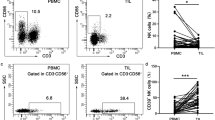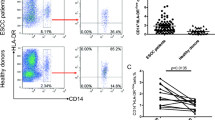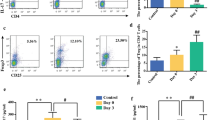Abstract
Dysregulation of helper T (Th) cell subsets has been contributed to the initiation and propagation of esophageal squamous cell carcinoma (ESCC). Different microRNAs (miRNAs) have been reported to control the development and functions of tumor-associated immune cells in ESCC. Here, we aimed to assess the IL-10, TGF-β, IFN-γ, and IL-17a-producing CD3+CD8− T cells in association whit miR-21, miR-29b, miR-106a, and miR-155 expression in ESCC patients. A total of 34 ESCC patients including 12 newly diagnosed (ND) and 22 under-treatment (UT) cases and also 34 age-matched healthy donors were enrolled. Flow cytometric characterization of stimulated T cells was performed by staining of the cells with fluorescent conjugated specific anti-human CD3 and CD8 cell surface markers as well as IL-17a, IFN-γ, IL-10, and TGF-β intracytoplasmic cytokines. Circulating RNA was extracted from the plasma, and qRT-PCR was used to evaluate the expression of microRNAs. TGF-β plasma levels were also assessed by ELISA. Results showed that the frequency of Th cells was significantly reduced in patients. A significant increase in Treg as well as Th17 cells population in both patient subgroups was observed. ND patients showed elevated level of Th1 cells and IL-10. However the mean expression of IFN-γ was significantly decreased in Th cells. We also detected higher level of miR-21 in the ESCC patients which was significantly correlated with different subsets of Th cells. Our findings revealed that immune response related to the Th cells is highly impaired in ESCC patients. Association between miR-21 and Th subsets could be correlated with the impairment of anti-tumor immunity and ESCC pathogenesis, which could be potentially used as an important target for immunotherapeutic approaches.



Similar content being viewed by others
References
Napier KJ, Scheerer M, Misra S. Esophageal cancer: a review of epidemiology, pathogenesis, staging workup and treatment modalities. World J Gastrointest Oncol. 2014;6(5):112–20.
Mosavi-Jarrahi A, Mohagheghi MA. Epidemiology of esophageal cancer in the high-risk population of Iran. Asian Pac J Cancer Prev. 2006;7(3):375–80.
Kuai D-Y, Cheng J, Yang R-C, Liu T, Liu H, Liu F-G, et al. Th17/Treg cell imbalance in patients with early esophageal squamous cell carcinoma. Int J Clin Exp Pathol. 2016;9(8):8485–91.
Liang H, Fan J-H, Qiao Y-L. Epidemiology, etiology, and prevention of esophageal squamous cell carcinoma in China. Cancer Biol Med. 2017;14(1):33–41.
Jain S, Dhingra S. Pathology of esophageal cancer and Barrett’s esophagus. Ann Cardiothorac Surg. 2017;6(2):99–109.
Kono K, Kawaida H, Takahashi A, Sugai H, Mimura K, Miyagawa N, et al. CD4 (+) CD25high regulatory T cells increase with tumor stage in patients with gastric and esophageal cancers. Cancer Immunol Immunother. 2006;55(9):1064–71.
Fridman WH, Pagès F, Sautès-Fridman C, Galon J. The immune contexture in human tumours: impact on clinical outcome. Nat Rev Cancer. 2012;12(4):298–306.
Dunn GP, Koebel CM, Schreiber RD. Interferons, immunity and cancer immunoediting. Nat Rev Immunol. 2006;6(11):836–48.
Kim H-J, Cantor H. CD4 T-cell subsets and tumor immunity: the helpful and the not-so-helpful. Cancer Immunol Res. 2014;2(2):91–8.
Guéry L, Hugues S. Th17 cell plasticity and functions in cancer immunity. Biomed Res Int. 2015;2015:1–11.
Chen D, Jiang R, Mao C, Shi L, Wang S, Yu L, et al. Chemokine/chemokine receptor interactions contribute to the accumulation of Th17 cells in patients with esophageal squamous cell carcinoma. Hum Immunol. 2012;73(11):1068–72.
Chen D, Hu Q, Mao C, Jiao Z, Wang S, Yu L, et al. Increased IL-17-producing CD4+ T cells in patients with esophageal cancer. Cell Immunol. 2012;272(2):166–74.
Nagata J, Kijima H, Hatanaka H, Tokunaga T, Takagi A, Mine T, et al. Correlation between interleukin 10 and vascular endothelial growth factor expression in human esophageal cancer. Int J Mol Med. 2002;10(2):169–72.
Lebman DA, Edmiston JS, Chung TD, Snyder SR. Heterogeneity in the transforming growth factor β response of esophageal cancer cells. Int J Oncol. 2002;20(6):1241–6.
Song JH, Meltzer SJ. MicroRNAs in pathogenesis, diagnosis, and treatment of gastroesophageal cancers. Gastroenterology. 2012;143(1):35–47.
Zhou S-L, Wang L-D. Circulating microRNAs: novel biomarkers for esophageal cancer. World J Gastroenterol: WJG. 2010;16(19):2348–54.
Meng X, Lu P, Mei J, Liu G, Fan Q. Expression analysis of miRNA and target mRNAs in esophageal cancer. Braz J Med Biol Res. 2014;47(9):811–7.
Hiyoshi Y, Kamohara H, Karashima R, Sato N, Imamura Y, Nagai Y, et al. MicroRNA-21 regulates the proliferation and invasion in esophageal squamous cell carcinoma. Clin Cancer Res. 2009;15(6):1915–22.
Steiner DF, Thomas MF, Hu JK, Yang Z, Babiarz JE, Allen CD, et al. MicroRNA-29 regulates T-box transcription factors and interferon-γ production in helper T cells. Immunity. 2011;35(2):169–81.
Zheng X, Dong L, Wang K, Zou H, Zhao S, Wang Y, et al. MiR-21 participates in the PD-1/PD-L1 pathway-mediated imbalance of Th17/Treg cells in patients after gastric Cancer resection. Ann Surg Oncol. 2019;26(3):884–93.
Yao R, Ma Y-L, Liang W, Li H-H, Ma Z-J, Yu X, et al. MicroRNA-155 modulates Treg and Th17 cells differentiation and Th17 cell function by targeting SOCS1. PLoS One. 2012;7(10):e46082.
Sonkoly E, Janson P, Majuri M-L, Savinko T, Fyhrquist N, Eidsmo L, et al. MiR-155 is overexpressed in patients with atopic dermatitis and modulates T-cell proliferative responses by targeting cytotoxic T lymphocyte–associated antigen 4. J Allergy Clin Immunol. 2010;126(3):581–9.
Banerjee A, Schambach F, DeJong CS, Hammond SM, Reiner SL. Micro-RNA-155 inhibits IFN-γ signaling in CD4+ T cells. Eur J Immunol. 2010;40(1):225–31.
Wang P, Xu L-J, Qin J-J, Zhang L, Zhuang G-H. MicroRNA-155 inversely correlates with esophageal cancer progression through regulating tumor-associated macrophage FGF2 expression. Biochem Biophys Res Commun. 2018;503(2):452–8.
Ma H, Wen X, Zhang X, Wang X, Zhao D, Che S, et al. miR-106a* inhibits the proliferation of esophageal carcinoma cells by targeting CDK2-associated Cullin 1 (CACUL1). Cell Mol Biol (Noisy-le-Grand). 2015;61(4):56–62.
Sharma A, Kumar M, Aich J, Hariharan M, Brahmachari SK, Agrawal A, et al. Posttranscriptional regulation of interleukin-10 expression by hsa-miR-106a. Proc Natl Acad Sci. 2009;106(14):5761–6.
Hong Z, Hong H, Liu J, Zheng X, Huang M, Li C, et al. miR-106a is downregulated in peripheral blood mononuclear cells of chronic hepatitis B and associated with enhanced levels of interleukin-8. Mediat Inflamm. 2015;2015:629862.
Memarian A, Nourizadeh M, Masoumi F, Tabrizi M, Emami AH, Alimoghaddam K, et al. Upregulation of CD200 is associated with Foxp3+ regulatory T cell expansion and disease progression in acute myeloid leukemia. Tumor Biol. 2013;34(1):531–42.
Baran J, Kowalczyk D, Oz M, Zembala M. Three-color flow cytometry detection of intracellular cytokines in peripheral blood mononuclear cells: comparative analysis of phorbol myristate acetate-ionomycin and phytohemagglutinin stimulation. Clin Diagn Lab Immunol. 2001;8(2):303–13.
Begenik H, Turkdogan MK, Dulger AC, Aldemir MN, Esen R, Mete R. Clinical immunology peripheral blood levels of cellular and humoral immunity parameters in esophageal and gastric cancer patients. Cent Eur J Immunol. 2013;38(3):355–7.
Nana-Sinkam S, Croce C. Clinical applications for microRNAs in cancer. Clin Pharmacol Ther. 2013;93(1):98–104.
O'connell RM, Rao DS, Chaudhuri AA, Baltimore D. Physiological and pathological roles for microRNAs in the immune system. Nat Rev Immunol. 2010;10(2):111–22.
Blanck G. Components of the IFN-gamma signaling pathway in tumorigenesis. Arch Immunol Ther Exp. 2002;50(3):151–8.
Dunn GP, Old LJ, Schreiber RD. The three Es of cancer immunoediting. Annu Rev Immunol. 2004;22:329–60.
Dunn GP, Bruce AT, Ikeda H, Old LJ, Schreiber RD. Cancer immunoediting: from immunosurveillance to tumor escape. Nat Immunol. 2002;3(11):991–8.
Shankaran V, Ikeda H, Bruce AT, White JM, Swanson PE, Old LJ, et al. IFNγ and lymphocytes prevent primary tumour development and shape tumour immunogenicity. Nature. 2001;410(6832):1107–11.
Wang Y, Liu D, Chen P, Koeffler HP, Tong X, Xie D. Negative feedback regulation of IFN-γ pathway by IFN regulatory factor 2 in esophageal cancers. Cancer Res. 2008;68(4):1136–43.
Wang Y, Liu D-P, Chen P-P, Koeffler HP, Tong X-J, Xie D. Involvement of IFN regulatory factor (IRF)-1 and IRF-2 in the formation and progression of human esophageal cancers. Cancer Res. 2007;67(6):2535–43.
Murugaiyan G, Saha B. Protumor vs antitumor functions of IL-17. J Immunol. 2009;183(7):4169–75.
Lu L, Weng C, Mao H, Fang X, Liu X, Wu Y, et al. IL-17A promotes migration and tumor killing capability of B cells in esophageal squamous cell carcinoma. Oncotarget. 2016;7(16):21853–64.
Korn T, Oukka M, Kuchroo V, Bettelli E. Th17 cells: effector T cells with inflammatory properties. Semin Immunol. 2007;19(6):362–71.
Shi Y, Liu X-F, Zhuang Y, Zhang J-Y, Liu T, Yin Z, et al. Helicobacter pylori-induced Th17 responses modulate Th1 cell responses, benefit bacterial growth, and contribute to pathology in mice. J Immunol. 2010;184:5121–9.
Yoshimura A, Muto G. TGF-β function in immune suppression. Curr Top Microbiol Immunol. 2011;350:127–47.
Joller N, Lozano E, Burkett PR, Patel B, Xiao S, Zhu C, et al. Treg cells expressing the coinhibitory molecule TIGIT selectively inhibit proinflammatory Th1 and Th17 cell responses. Immunity. 2014;40(4):569–81.
Xie J, Wang J, Cheng S, Zheng L, Ji F, Yang L, et al. Expression of immune checkpoints in T cells of esophageal cancer patients. Oncotarget. 2016;7(39):63669.
Gholamin M, Moaven O, Memar B, Farshchian M, Naseh H, Malekzadeh R, et al. Overexpression and interactions of interleukin-10, transforming growth factor β, and vascular endothelial growth factor in esophageal squamous cell carcinoma. World J Surg. 2009;33(7):1439–45.
Cao X. Regulatory T cells and immune tolerance to tumors. Immunol Res. 2010;46(1–3):79–93.
Grainger DJ, Mosedale DE, Metcalfe JC. TGF-β in blood: a complex problem. Cytokine Growth Factor Rev. 2000;11(1):133–45.
Winkler I, Wilczynska B, Bojarska-Junak A, Gogacz M, Adamiak A, Postawski K, et al. Regulatory T lymphocytes and transforming growth factor beta in epithelial ovarian tumors-prognostic significance. J Ovarian Res. 2015;8(1):39.
Sheen-Chen S-M, Chen H-S, Sheen C-W, Eng H-L, Chen W-J. Serum levels of transforming growth factor β1 in patients with breast cancer. Arch Surg. 2001;136(8):937–40.
Jarnicki AG, Lysaght J, Todryk S, Mills KH. Suppression of antitumor immunity by IL-10 and TGF-β-producing T cells infiltrating the growing tumor: influence of tumor environment on the induction of CD4+ and CD8+ regulatory T cells. J Immunol. 2006;177(2):896–904.
Del Prete G, De Carli M, Almerigogna F, Giudizi MG, Biagiotti R, Romagnani S. Human IL-10 is produced by both type 1 helper (Th1) and type 2 helper (Th2) T cell clones and inhibits their antigen-specific proliferation and cytokine production. J Immunol. 1993;150(2):353–60.
Levings MK, Sangregorio R, Galbiati F, Squadrone S, de Waal Malefyt R, Roncarolo M-G. IFN-α and IL-10 induce the differentiation of human type 1 T regulatory cells. J Immunol. 2001;166(9):5530–9.
Kicielińska J, Pajtasz-Piasecka E. The role of IL-10 in the modulation of the immune response in normal conditions and the tumor environment. Postepy Hig Med Dosw (Online). 2014;68:879–92.
Murugaiyan G, da Cunha AP, Ajay AK, Joller N, Garo LP, Kumaradevan S, et al. MicroRNA-21 promotes Th17 differentiation and mediates experimental autoimmune encephalomyelitis. J Clin Invest. 2015;125(3):1069–80.
Ugalde AP, Ramsay AJ, De La Rosa J, Varela I, Mariño G, Cadiñanos J, et al. Aging and chronic DNA damage response activate a regulatory pathway involving miR-29 and p53. EMBO J. 2011;30(11):2219–32.
Zhu Q, Wang Z, Hu Y, Li J, Li X, Zhou L, et al. miR-21 promotes migration and invasion by the miR-21-PDCD4-AP-1 feedback loop in human hepatocellular carcinoma. Oncol Rep. 2012;27(5):1660–8.
Dong J, Zhao Y-P, Zhou L, Zhang T-P, Chen G. Bcl-2 upregulation induced by miR-21 via a direct interaction is associated with apoptosis and chemoresistance in MIA PaCa-2 pancreatic cancer cells. Arch Med Res. 2011;42(1):8–14.
Yan B, Guo Q, Fu F-j, Wang Z, Yin Z, Wei Y-b, et al. The role of miR-29b in cancer: regulation, function, and signaling. Onco Targets Ther. 2015;8:539–48.
Wei W, Wang Y, Yu X, Ye L, Jiang Y, Cheng Y. Expression of TP53, BCL-2, and VEGFA genes in esophagus carcinoma and its biological significance. Med Sci Monit. 2015;21:3016–22.
Qi Y, Li X, Zhao S. miR-29b inhibits the progression of esophageal squamous cell carcinoma by targeting MMP-2. Neoplasma. 2015;62(3):384–90.
Jiang H, Zhang G, Wu J-H, Jiang C-P. Diverse roles of miR-29 in cancer. Oncol Rep. 2014;31(4):1509–16.
Funding
This article was derived from a thesis of M.Sc. degree in the field of Immunology (Grant No. 978) at Semnan University of Medical Sciences, Semnan, Iran, in collaboration with Golestan University of Medical Sciences (Grant No. 950131021).
Author information
Authors and Affiliations
Corresponding author
Ethics declarations
Research involving human participants
The present study which involved human participants was approved by the ethical committee of Semnan University of Medical Sciences (Code of Ethics: IR.SEMUMS.REC.1394.215) and also Golestan University of Medical sciences (Code of Ethics: IR.GOUMS.REC.1395.28). A written informed consent following the declaration of Helsinki was taken from all participants.
Conflict of interest
The authors declare that they have no conflict of interest.
Additional information
Publisher’s note
Springer Nature remains neutral with regard to jurisdictional claims in published maps and institutional affiliations.
Rights and permissions
About this article
Cite this article
Samiei, H., Sadighi-Moghaddam, B., Mohammadi, S. et al. Dysregulation of helper T lymphocytes in esophageal squamous cell carcinoma (ESCC) patients is highly associated with aberrant production of miR-21. Immunol Res 67, 212–222 (2019). https://doi.org/10.1007/s12026-019-09079-7
Published:
Issue Date:
DOI: https://doi.org/10.1007/s12026-019-09079-7




